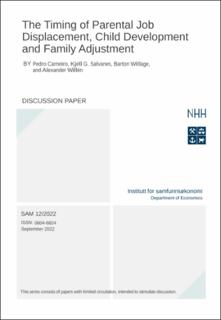| dc.contributor.author | Carneiro, Pedro | |
| dc.contributor.author | Salvanes, Kjell G. | |
| dc.contributor.author | Willage, Barton | |
| dc.contributor.author | Willén, Alexander | |
| dc.date.accessioned | 2022-10-03T12:45:30Z | |
| dc.date.available | 2022-10-03T12:45:30Z | |
| dc.date.issued | 2022-09 | |
| dc.identifier.issn | 0804-6824 | |
| dc.identifier.uri | https://hdl.handle.net/11250/3023380 | |
| dc.description.abstract | This paper examines if the effect of parental labor market shocks on child development depends on the age of the child at the time of the shock. To address this question, we leverage rich Norwegian population-wide register data and exploit mass layoffs and establishment closures as a source of exogenous variation in parental labor market shocks. We find that, even though displacement episodes early in children’s lives have the largest impacts on household income (because they persist for many years), displacement episodes occurring in the children’s teenage years have the largest effects on human capital accumulation. We show that most of the effects operate through the intensive margin of schooling, and that children – across childhood – are significantly more influenced by maternal labor shocks compared to paternal labor shocks. In terms of mechanisms, we show that the heterogeneous effects across child age likely are driven by short-term increases in maternal stress rather than by differences in how the parents respond to the shocks. | en_US |
| dc.language.iso | eng | en_US |
| dc.relation.ispartofseries | SAM DP;12/2022 | |
| dc.subject | Job Displacement, Labor Market Shocks, Intergenerational Transmission, Human Capital | en_US |
| dc.title | The Timing of Parental Job Displacement, Child Development and Family Adjustment | en_US |
| dc.type | Working paper | en_US |
| dc.source.pagenumber | 67 | en_US |
| dc.relation.project | Norges Forskningsråd: 262675 | en_US |
